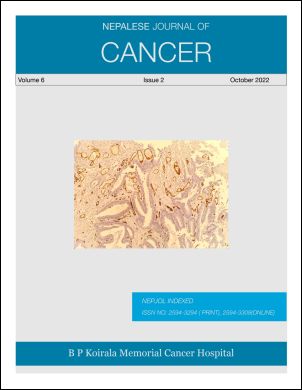Early enteral feeding using nasojejunal tube after gastric cancer surgery is safe and effective: a single unit experience from cancer hospital
DOI:
https://doi.org/10.3126/njc.v6i2.48755Keywords:
Naso-jejunal tube feeding, early enteral feeding, gastrectomyAbstract
Introduction: Patients are kept nil per oral (NPO) after surgery for gastric cancer and all patients receives intravenous fluids till oral feed is commenced. There is established benefit of enteral nutrition after surgery for gastric cancer. Early oral feeding comes with lots of hesitation for execution, so to offer benefits of early enteral nutrition and to avoid early oral feeding, nasojejunal tube (NJ) feeding can be used as alternative to feeding jejunostomy (FJ) and also total parenteral nutrition (TPN) can be avoided. The aim of this study is to present our experience of early enteral feeding using NJ tube and to convey the message that early feeding using NJ tube is safe, effective and has less complications.
Methods: This is a retrospective study of patients operated between April 2019 to March 2022, who had nasojejunal tube placed at the time of surgery. NJ tube was placed in the efferent limb of jejunum. Feeding was started from post operative day 1 and gradually progressed over days. NJ tube was removed after adequate oral intake.
Results: Sixty patients were eligible for final analysis. Median age of patients was 61 years, IQR (53-69). Thirty-three patients underwent D2-subtotal gastrectomy, 16 underwent D2-total gastrectomy and 10 underwent gastro-jejunostomy. Median time for discharge is 12 days, IQR (12-14). The median time for NJ removal is 10 days, IQR (9-12). Thirty-four patients reported complications related to NJ feed, all were minor and easily manageable.
Conclusion: NJ tube feeding offers the advantages of early enteral feeding after gastric cancer surgery. It is technically easy to use and should be advocated for its simplicity, low costs and great advantages as compared to FJ and TPN.
Downloads
Downloads
Published
How to Cite
Issue
Section
License
Copyright (c) 2022 Nepalese Journal of Cancer

This work is licensed under a Creative Commons Attribution 4.0 International License.
This license lets others distribute, remix, tweak, and build upon your work, even commercially, as long as NJC and the authors are acknowledged.
Submission of the manuscript means that the authors agree to assign exclusive copyright to NJC. The aim of NJC is to increase the visibility and ease of use of open access scientific and scholarly articles thereby promoting their increased usage and impact.




